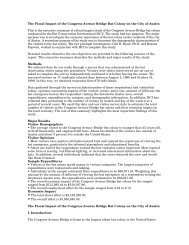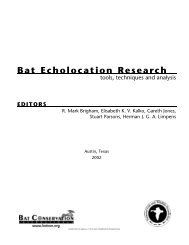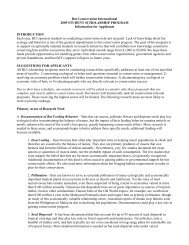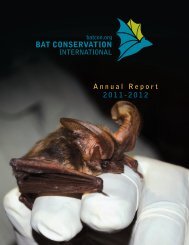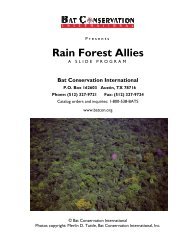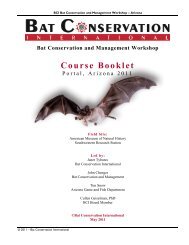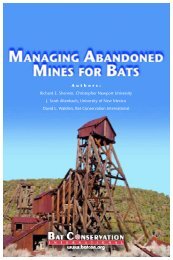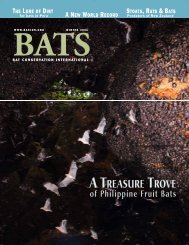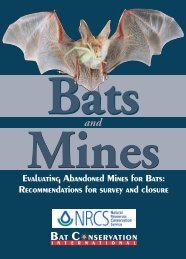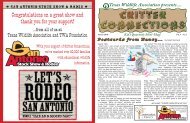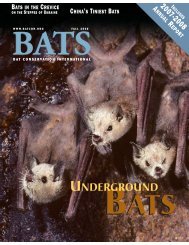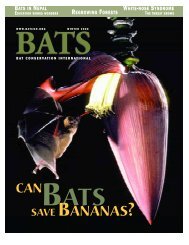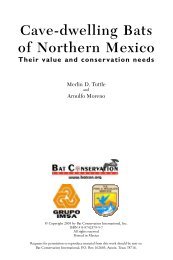Bat House Discovery - Bat Conservation International
Bat House Discovery - Bat Conservation International
Bat House Discovery - Bat Conservation International
You also want an ePaper? Increase the reach of your titles
YUMPU automatically turns print PDFs into web optimized ePapers that Google loves.
VOLUME 12, NO. 1 SPRING 2004<br />
THE<br />
BAT HOUSE RESEARCHER<br />
NEWSLETT ER OF THE NORT H AMERICAN BAT HOUSE RESEARCH PROJECT<br />
A Decade of<br />
<strong>Bat</strong> <strong>House</strong> <strong>Discovery</strong><br />
Mark and Selena Kiser<br />
This is the last printed issue of The <strong>Bat</strong> <strong>House</strong><br />
Researcher. See pages 4 and 5 for details about<br />
the project’s new mission, how to stay involved<br />
and how to receive future bat house updates.<br />
The Fall 2003 issue of The Researcher was not published<br />
to allow preparation of this special double issue.<br />
The North American <strong>Bat</strong> <strong>House</strong> Research Project<br />
has revolutionized our ability to help bats in need<br />
of homes, thanks to the 7,000 Research Associate<br />
volunteers and colleagues who, over more than a decade,<br />
have shared their findings from varied climates and habitats<br />
across the continent. Today, at least 16 of 46 U.S. and<br />
Canadian bat species are using bat houses and other artificial<br />
roosts that shelter tens of thousands of bats, with<br />
100,000 in just one extra-large structure.<br />
Our effo rts have mostly focused on species that prefer<br />
to roost in 3 ⁄4-inch (19-millimeter) crev i c e s, and, with<br />
the help of our Research Associates, we developed a<br />
basic bat house design that has proven acceptabl e<br />
for the majority of Ameri c a ’s most widespread<br />
s p e c i e s. Such houses, which do not require<br />
species-specific know l e d g e, enable countless<br />
n ovice bat fa n c i e r s, fa rmers and wildlife managers<br />
to install successful bat houses.<br />
By sharing and analyzing the results of<br />
numerous tests involving crev i c e - d we l l i n g<br />
species in wide-ranging habitats and climates,<br />
we have clearly documented key<br />
requirements. As research progressed, we<br />
p e riodically added new, more-refined<br />
r e p o rting categori e s, which limits the<br />
number of years available for cross-comparison.<br />
We are, however, able to make<br />
consistent comparisons for 1,553 bat<br />
houses reported from 1998 to 2001.
2 SPRING 2004<br />
THE BAT HOUSE RESEARCHER<br />
Early Efforts<br />
In the 1980s, most bat houses were small,<br />
unpainted, uncaulked and mounted in<br />
shaded locations on trees, often with roost<br />
chambers more than 1 inch (2.5 centimeters)<br />
deep (front to back). Then, in 1992,<br />
BCI’s first survey of occupancy success in<br />
North America revealed that most bats prefer<br />
painted houses, with 3 ⁄4-inch (19-millimeter)<br />
roosting chambers, especially when<br />
mounted in full sun on buildings and poles.<br />
These findings led to publication of The <strong>Bat</strong><br />
<strong>House</strong> Builder’s Handbook, which also identified<br />
important areas for further research.<br />
Fully understanding bat needs requires<br />
n u m e rous comparisons involving many<br />
species living in diverse climates and habitats,<br />
an impossible task without lots of volunteer<br />
help. BCI’s founding of the North<br />
American <strong>Bat</strong> <strong>House</strong> Re s e a rch Pro j e c t<br />
enabled continent-wide sharing of consistent<br />
data.<br />
Local testing has contributed dramatically<br />
to bat house successes, with occupancy<br />
improving from 23 percent in 1995 to 61<br />
percent by 2000. Those who carefully follow<br />
our latest guidelines for construction and<br />
mounting are achieving success rates of 80<br />
to 90 percent!<br />
Lessons Learned<br />
Though a wide range of bat house sizes<br />
and styles are still being used, we find that<br />
bats prefer larger houses and those mounted<br />
on buildings or other large wooden or concrete<br />
structures (Tables 1 and 2). Both preferences<br />
help buffer day-to-night temperature<br />
fluctuations, which appear to be a dominant<br />
concern for roosting bats, especially<br />
nursery colonies. For bat houses mounted<br />
on buildings, those with chambers at least<br />
20 inches (50.8 centimeters) wide (side to<br />
side) were inhabited 82 percent of the time<br />
(83 of 101 houses); houses of the same<br />
width and with chambers at least 25 inches<br />
(63.5 centimeters) tall achieved 90 percent<br />
occupancy (37 of 41 houses).<br />
Local testing remains a key element in<br />
success. Our findings suggest that the best<br />
approach is to begin by testing two or three<br />
– usually not more than six – bat houses,<br />
until the first bats move into the design and<br />
location they prefer.<br />
Aside from basic shelter against the elements<br />
and predators, all roosts must maintain<br />
appropriate temperatures<br />
for a given species.<br />
Most colonial bat house<br />
tenants seek daytime<br />
t e m p e r a t u res of 80° to<br />
100° F (27° to 38° C) for<br />
rearing young, although<br />
some tolerate even higher<br />
temperatures.<br />
In very cold climates,<br />
testing should begin with<br />
black, unvented houses,<br />
mostly placed in the sunniest<br />
locations. In ve ry<br />
hot areas, the opposite<br />
applies, though houses<br />
should rarely receive less<br />
than six hours of daily<br />
sun exposure anywhere.<br />
In most intermediate climates,<br />
it’s best to test<br />
dark colors versus light<br />
colors or white, often side<br />
by side.<br />
Buildings provide good<br />
mounting locations<br />
almost eve ry w h e re, but<br />
they are essential in extra<br />
cool or dry climates. In<br />
dry regions, where dayto-night<br />
temperature s<br />
may shift by more than<br />
28° F (15.6° C), buffering<br />
from nighttime extremes<br />
is needed.<br />
W h e re climates are<br />
moderate to hot with<br />
average to high humidity,<br />
it is best to test pairs of<br />
houses mounted back-toback<br />
on poles – a light<br />
one facing north and a moderate to dark<br />
one facing south. <strong>House</strong>s can also be tested<br />
side by side on buildings, with both houses<br />
facing the same direction, in any climate. By<br />
observing roost choices of the first occupants,<br />
bat preferences can be determined<br />
and met by varying the color or sun exposure<br />
for subsequent houses.<br />
In intermediate to hot climates, bats<br />
typically prefer vented houses, with open<br />
bottoms, that provide a wider range of temperatures<br />
in a single house. This permits the<br />
bats to move vertically to find preferred<br />
roosting temperatures as exterior temperatures<br />
change.<br />
<strong>Bat</strong> <strong>House</strong> Project Coordinator Mark Kiser installs bat houses on<br />
the side of a California barn. <strong>Bat</strong> houses mounted on buildings<br />
performed best in our surveys, especially in hot, dry climates.<br />
In the coolest climates, houses can be tested<br />
without vents and with all but 3 ⁄4 inch (19<br />
millimeters) of the sloping bottom covered;<br />
this combination increases inside temperature<br />
by reducing air circulation.<br />
All bat houses should be caulked and<br />
painted or stained to prevent deterioration<br />
and leaks. Any leaks that develop must be<br />
repaired. Except in extreme southern Florida<br />
and the western United States, where<br />
larger species may prefer 1- to 1 3 ⁄4-inch (25-<br />
to 44-millimeter) crevices, 3 ⁄4-inch (19-millimeter)<br />
crevices seem to be preferred. To the<br />
extent possible, locate all houses approximately<br />
20 to 30 feet (6.1 to 9.1 meters)
Volume 12, No. 1 3<br />
THE BAT HOUSE RESEARCHER<br />
from the nearest trees and at least 10 feet (3<br />
meters) – preferably 12 to 20 feet (3.7 to 6.1<br />
meters) – above ground (or above the tallest<br />
vegetation beneath the bat house). Those<br />
located nearest an area’s largest water sources<br />
are typically the most successful, as are those<br />
in or adjacent to the most diverse or natural<br />
vegetation (Table 1).<br />
Especially after local preferences are determined,<br />
erecting multiple houses is an excellent<br />
strategy. During periods of extreme<br />
weather, bats may need houses that are substantially<br />
cooler or warmer than normal.<br />
They may also switch roosts to escape parasites<br />
and some routinely move among a<br />
series of roosts, apparently as a predatoravoidance<br />
strategy. More room also means<br />
more space for a colony to expand. Options<br />
include offering different designs, compass<br />
orientations, exterior colors and hours of<br />
direct sun exposure.<br />
Our combined surveys show that when<br />
three or more houses were installed in a<br />
group, 80 percent were successful (197 of<br />
245 houses). Single houses succeeded only<br />
49 percent of the time (321 of 657 houses).<br />
Multiple houses are especially important<br />
when they are relatively small. When large<br />
colonies are to be evicted from buildings,<br />
multiple or larger houses increase the odds<br />
that displaced bats will find adequate space.<br />
Varying placement to obtain more or less<br />
solar heating also helps.<br />
<strong>Bat</strong> house designs and materials continue<br />
to evolve, but key features for all bat houses<br />
Research Associate Brian Murphy inspects<br />
a two-chamber rocket box. Rocket boxes<br />
had slightly higher occupancy than nursery<br />
and large houses in our study, but they<br />
attracted smaller colonies on average.<br />
Even in big cities, bat houses can be quite successful. Big brown bats find shelter in this suburban,<br />
backyard bat house within 1 ⁄3 mile ( 1 ⁄2 kilometer) of a busy interstate highway in Houston, Texas.<br />
should include roost chambers at least 20<br />
inches (51 centimeters) tall, caulked or<br />
sealed joints, well-painted or -stained exteriors,<br />
rough-surface landing areas and ventilation<br />
slots (except in cold climates). The<br />
more chambers and the taller and wider<br />
(side to side) those chambers are the better.<br />
The “standard” models that fared best in<br />
our surveys were nursery and rocket houses<br />
(Table 2). Nursery houses – characterized by<br />
tall, multiple chambers, as opposed to a single<br />
roosting space – were used for rearing<br />
young twice as often as single-chamber<br />
houses. Rocket boxes were 6 percent more<br />
successful in attracting bats than nursery<br />
models, but 8 percent less likely to support<br />
nursery use. The high overall use of rocket<br />
boxes appears to stem from the increased<br />
temperature range available to occupants as<br />
they move between sunny and shaded sides<br />
along an extra-long vertical axis.<br />
Nursery houses, with their large surface<br />
area, provide greater exposure for solar heating,<br />
while their multiple chambers reduce<br />
the odds of overheating young bats. Large<br />
houses, with 15 to 50 feet (4.6 to 15.2<br />
meters) of linear roosting space, had the<br />
highest overall maternity use. While not<br />
everyone can build or erect such houses,<br />
adding height, width and additional roosting<br />
chambers appears to increase the odds of<br />
nursery use for any style of house.<br />
The species most commonly re p o rted in<br />
No rth American bat houses are the little<br />
b rown myotis (Myotis lucifugus) ,<br />
Mexican free-tailed bat (Ta d a r i d a<br />
b ra s i l i e n s i s) and big brown bat<br />
(Eptesicus fuscus). No matter where<br />
you live in the lower 48 states and<br />
much of Alaska and Canada, yo u<br />
h a ve the chance to attract at least<br />
one of these species, all of which<br />
differ in habitat and water pre f e r-<br />
ences (Table 4). For example, fre e -<br />
tailed bats occupy houses fart h e r<br />
f rom water, we re less associated<br />
with forests and occurred more<br />
often in urban and suburban areas.<br />
Time until first occupancy is<br />
reported in Table 3. Most of the<br />
occupied houses attracted bats<br />
within the first year (average: nine<br />
months), while 89 percent were<br />
used within two years. One bat<br />
house was not inhabited until 13<br />
years, 2 months after installation.
4 SPRING 2004<br />
THE BAT HOUSE RESEARCHER<br />
Little brown myotis pack the crevices of this bat house in Pennsylvania. <strong>Bat</strong> house enthusiasts who follow the guidelines developed over<br />
the past decade by the North American <strong>Bat</strong> <strong>House</strong> Research Project dramatically improve their chances of success.<br />
Project Future<br />
In order to devote more time and<br />
re s o u rces to innova t i ve experimentation, we<br />
will no longer solicit, analyze and publish<br />
general bat house data in The <strong>Bat</strong> Ho u s e<br />
Re s e a rc h e r and there will no longer be a participant<br />
subscription fee, although contributions<br />
to help support the project are cert a i n-<br />
ly we l c o m e .<br />
We will share our research and results<br />
electronically, through our existing North<br />
American <strong>Bat</strong> <strong>House</strong> Research Project website<br />
(www.batcon.org/bhra), which is now<br />
called the <strong>Bat</strong> <strong>House</strong> Project to better reflect<br />
our expanding goals and international participation.<br />
This site will be updated with new findings<br />
and test results to better serve our<br />
Research Associates and bat house enthusiasts<br />
everywhere. We will have quarterly bat<br />
house articles in BCI’s free electro n i c<br />
newsletter (see page 5) and occasionally in<br />
BATS magazine (a BCI member benefit).<br />
The savings from discontinuing our printed<br />
newsletter will be used to expand testing<br />
t h rough small grants and on-site assistance.<br />
We still need to improve bat house durab<br />
i l i t y, ease of construction, life span and<br />
a t t r a c t i veness. Im p roved designs, mounting<br />
strategies and/or thermostat-controlled heating<br />
techniques are needed to better meet bat<br />
needs in exceptionally cool or fluctuating climates.<br />
Refinements are also needed to better<br />
accommodate individual species, especially<br />
those that are endangered or declining.<br />
Our past emphasis on meeting the needs<br />
of small, cre v i c e - d welling bats has also<br />
helped some threatened and endangered bat<br />
species, but other species have differe n t<br />
roosting needs, such as open cavities or<br />
unusual crevices.<br />
Help Needed<br />
Testing bat needs over a wide range of<br />
species and climates remains a daunting<br />
challenge that can only be met by continued<br />
volunteer participation, so BCI offers new<br />
opportunities for you to partner with us. If<br />
you live in an area with special problems or<br />
species needs and are willing to conduct or<br />
monitor local experiments, please contact<br />
us. We may be able to help with a small<br />
grant or by supplying the specific kinds of<br />
Join<br />
BCI<br />
Today<br />
If you’re not a member of <strong>Bat</strong> <strong>Conservation</strong> <strong>International</strong>, we hope that you’ll consider joining us. It’s<br />
easy: Sign up online at www.batcon.org or call us at 1-800-538-BATS. Become a BCI member and<br />
receive these great benefits:<br />
➧ Four issues of BATS magazine each year<br />
➧ Discounts on catalog items<br />
➧ Exclusive Member Night visits to Bracken Cave, the Texas home of the world’s largest bat colony<br />
➧ Opportunities to participate in workshops and field projects<br />
➧ Invitations to join fascinating international ecotours<br />
You don’t have to be a member to donate to the <strong>Bat</strong> <strong>House</strong> Project.<br />
To make a donation in any amount, go to www.batcon.org/topdonation.html or call (512) 327-9721.
Volume 12, No. 1 5<br />
THE BAT HOUSE RESEARCHER<br />
bat houses, materials or devices you need for<br />
testing. We may even be able to come and<br />
help you design and set up your experiment.<br />
So let us hear from you so we<br />
can discuss your project.<br />
We are always looking for<br />
n ew ideas. Let us know when<br />
you discover new materials<br />
that offer easier constru c t i o n ,<br />
g reater durability or less weight. A few<br />
years ago, for example, no one would have<br />
b e l i e ved that plastic houses would now rank<br />
among our most successful designs. Another<br />
n ew idea uses re l a t i vely inexpensive, thermos<br />
t a t - c o n t rolled heating devices (see “He a t e d<br />
<strong>Bat</strong> <strong>House</strong>s,” page 11), which hold gre a t<br />
p romise where cool nights are a pro b l e m .<br />
We have recently made great strides in<br />
developing artificial caves and simulated tree<br />
hollows that are needed by some species,<br />
and we anticipate additional advances to<br />
come. So contact us if you have an idea or<br />
testing opportunity.<br />
We are especially looking for vo l u n t e e r<br />
Re s e a rch Associates who live in geographical<br />
a reas where tests are most critically needed,<br />
i n c l u d i n g :<br />
1. In arid and semiarid areas of the We s t<br />
and So u t h west, we need better methods to<br />
p rotect against large drops in nighttime temp<br />
e r a t u res. Similar tests are needed in extracool<br />
mountainous or northern re g i o n s .<br />
2. Pallid bats (Antrozous pallidus) and<br />
Tow n s e n d’s big-eared bats (C o ry n o rh i n u s<br />
townsendii) in the western United States and<br />
Canada are declining, and these bats need<br />
the help we believe our project can provide.<br />
If either of these species inhabits your area<br />
and you’d like to help with tests to meet<br />
their needs, please let us know.<br />
3. The endangered Indiana myotis (Myotis<br />
sodalis), which is found throughout much of<br />
the eastern United States, has recently been<br />
attracted to bat houses, and we<br />
encourage further research on its preferences.<br />
Again, if you live where this species<br />
occurs, please contact us.<br />
4. In the southeastern United States, we<br />
are achieving excellent results with simulated<br />
tree hollows made from ve rt i c a l l y<br />
stacked, concrete road culverts. We plan to<br />
expand testing where there are known populations<br />
of Rafinesque’s big-eared bats<br />
(Corynorhinus rafinesquii) or southeastern<br />
myotis (Myotis austroriparius).<br />
5. In southern Florida, a small nursery<br />
colony of critically endangered Wagner’s<br />
bonneted bats (Eumops glaucinus) was<br />
recently found using a small bat house (page<br />
9). We are already testing their preferences<br />
at that location and would very much appreciate<br />
hearing from potential volunteers for<br />
additional test sites. The Florida Keys also<br />
provide an opportunity to test housing for<br />
Pa l l a s’s mastiff bats (Molossus molossus) ,<br />
which use bat houses in the Caribbean.<br />
Please keep your ideas and reports coming.<br />
As in the past, we look forward to sharing<br />
your experiments and discoveries with<br />
fellow enthusiasts and colleagues worldwide.<br />
We remain interested in any test you may be<br />
conducting or discovery that would improve<br />
bat houses in general or enhance our ability<br />
The <strong>Bat</strong><br />
<strong>House</strong><br />
Project’s<br />
new mission<br />
will help pallid<br />
bats like this<br />
one, whose numbers are<br />
declining in the western<br />
United States and Canada.<br />
to accommodate a single species. So m e<br />
results will continue to be most easily<br />
re p o rted on our traditional data forms.<br />
These and other project materials are available<br />
online at www.batcon.org/bhra.<br />
<strong>Bat</strong> house success continues to spread to<br />
other countries and continents. BCI recently<br />
provided advice and/or received reports of<br />
occupied bat houses in Colombia, Costa<br />
Rica, Senegal, South Africa and Australia.<br />
Be sure to catch BCI’s electronic newsletter,<br />
BATS magazine and our website for the latest<br />
stories and tips from around the world.<br />
Not everyone can buy land to protect a<br />
cave or build a steel gate to safeguard bats in<br />
a mine. But installing bat houses is one way<br />
the average person can make a real difference.<br />
Thank you for supporting the project<br />
and for helping bats find new homes for all<br />
these years. Please stay in touch with us at<br />
bathouses@batcon.org as we continue our<br />
journey of discovery.<br />
Back issues of The Researcher<br />
will remain available on our website at:<br />
www.batcon.org/bhra<br />
Sign up for BCI’s Electronic Newsletter<br />
You can stay up to date on the latest bat news and bat house discoveries with BCI’s electronic newsletter. It’s quick, easy and free.<br />
Visit BCI’s website at www.batcon.org and click the e-newsletter button on the home page, then the “Sign up for the E-newsletter”<br />
button and follow the instructions. <strong>Bat</strong> house news, tips and more will be included quarterly in the e-newsletter.<br />
Your privacy is important to BCI. We will never sell, lease, exchange or lend your name or email information to any other group,<br />
organization or business. Your email information will be used by BCI only, and only for the e-newsletter or for updates relating to<br />
your stated areas of interest. The e-newsletter will be sent once a month.
6 SPRING 2004<br />
THE BAT HOUSE RESEARCHER<br />
OV ERALL PROJEC T SUCCESS AND RESULT S<br />
1998 – 2001 COMBINED SUR V E Y S<br />
Table 1: Su rvey Results and Factors Affecting <strong>Bat</strong> <strong>House</strong> Su c c e s s<br />
Occupancy<br />
Rate<br />
Increasing Success<br />
Number<br />
of <strong>House</strong>s<br />
1995 Annual Survey 23% 124 of 536<br />
1996 Annual Survey 37% 215 of 577<br />
1998 Annual Survey 57% 445 of 778<br />
2000 Annual Survey 61% 388 of 636<br />
Mounting Location<br />
Trees 20% 25 of 125<br />
Poles 52% 503 of 960<br />
Wooden/Masonry Buildings 64% 264 of 411<br />
Roost Chamber Height<br />
Less than 15” (38.1 cm) 44% 98 of 222<br />
15 to 24” (38.1-61 cm) 51% 485 of 957<br />
25” or more (63.5 cm) 64% 239 of 374<br />
Roost Chamber Width (side to side)<br />
Less than 15” (38.1 cm) 51% 179 of 348<br />
15 to 24” (38.1-61 cm) 55% 385 of 698<br />
25” or more (63.5 cm) 72% 84 of 117<br />
Number of Chambers<br />
1 or 2 50% 243 of 490<br />
3 or 4 50% 386 of 768<br />
5 or more 65% 193 of 295<br />
Urbanization<br />
Urban 41% 46 of 112<br />
Suburban 42% 112 of 267<br />
Rural 57% 664 of 1,174<br />
Occupancy<br />
Rate<br />
Number<br />
of <strong>House</strong>s<br />
Dominant Land Use Within 1-mile (1.6-km) radius<br />
Cattle Ranching 48% 32 of 66<br />
Residential 48% 146 of 306<br />
Farms/Natural Vegetation 57% 272 of 474<br />
Natural Vegetation 59% 304 of 519<br />
Dominant Farm Type Within 1-mile (1.6-km) radius<br />
Row Crops 24% 18 of 76<br />
Pastures/Row Crops 52% 156 of 298<br />
Pastures 53% 140 of 265<br />
Orchards 67% 37 of 55<br />
Pastures/Row Crops/Orchards 68% 103 of 152<br />
Dominant Natural Vegetation<br />
Wetland 28% 19 of 67<br />
Desert 31% 25 of 80<br />
Forest 54% 409 of 753<br />
Grassland 55% 142 of 259<br />
Overgrown Field/Shrub 61% 132 of 217<br />
Nearest Freshwater Source<br />
Marsh (all sizes) 38% 32 of 85<br />
Stream (less than 50’ wide) 50% 229 of 454<br />
Pond (less than 25 acres) 51% 234 of 463<br />
River (greater than 50’ wide) 60% 110 of 184<br />
Lake (greater than 25 acres) 61% 190 of 313<br />
[50 feet = 15.2 meters; 25 acres = 10.1 hectares]<br />
Table 2: <strong>House</strong> Design versus Occupancy and Use Ty p e<br />
Occupied With Number of bats: Overall Number<br />
Design (Linear Roost Space) Maternity Use Average Range Occupancy of houses<br />
Small/Single Chamber (
Volume 12, No. 1 7<br />
THE BAT HOUSE RESEARCHER<br />
Table 3: Time Until First Occupancy (735 occupied houses)<br />
Average: 9 months. Range: 0 to 158 months.<br />
Percentage of<br />
Time Occupied <strong>House</strong>s Number of <strong>House</strong>s<br />
48 months 3% 22<br />
Table 4: Di f f e rences Among T h ree<br />
Most Common <strong>Bat</strong> Ho u s e - Using Sp e c i e s<br />
Urbanization Rural Suburban Urban<br />
Little brown myotis (175 houses) 91% 8% 1%<br />
Big brown bat (104 houses) 83% 9% 8%<br />
Mexican free-tailed bat (122 houses) 58% 21% 21%<br />
Farms/<br />
Natural<br />
Dominant Land Use Residential Natural Vegetation Vegetation Other<br />
Little brown myotis (175 houses) 5% 38% 54% 3%<br />
Big brown bat (104 houses) 19% 15% 51% 15%<br />
Mexican free-tailed bat (122 houses) 44% 34% 15% 7%<br />
Distance to Water Less than 1/4 mile 1/4 to 1 mile More than 1 mile [1 mile = 1.6 kilometers]<br />
Little brown myotis (175 houses) 93% 6% 1%<br />
Big brown bat (104 houses) 84% 16% 0%<br />
Mexican free-tailed bat (122 houses) 66% 13% 21%<br />
Dominant Overgrown Other Vegetation/<br />
Natural Vegetation Desert Grassland Field/Shrub Forest Mixed<br />
Little brown bat (175 houses) 0% 12% 14% 74% 0%<br />
Big brown bat (104 houses) 0% 27% 26% 42% 5%<br />
Mexican free-tailed bat (122 houses) 11% 29% 12% 20% 28%<br />
This bat house full of Mexican free-tailed bats is located where grasslands are the predominant vegetation. In our surveys, free-tailed bats<br />
used bat houses in grasslands more than any other natural vegetation type.
8 SPRING 2004<br />
THE BAT HOUSE RESEARCHER<br />
BAT HOUSE HALL OF FAME<br />
The No rth American <strong>Bat</strong> Ho u s e<br />
Re s e a rch Pro j e c t – and countless bat<br />
colonies – have benefited immensely<br />
f rom the innovations and dedication of these<br />
early pioneers. We owe them a great debt for<br />
sharing the knowledge they worked so hard<br />
to obtain.<br />
FR A N K A N D TE R E S A BI B I N, Georgia – T h e<br />
first organic growers to demonstrate the<br />
value of bats for pest reduction in pecan<br />
o rc h a rd s .<br />
KE N T BO RC H E R D I N G, Wisconsin –<br />
Attracted one of the largest little brow n<br />
m yotis colonies to bat houses and contributed<br />
the most data re p o rt forms to the<br />
p ro j e c t .<br />
LO I S BLU M E N T H A L, Cayman Islands –<br />
Founded an extensive project to prov i d e<br />
homes and test pre f e rences for excluded Pa l-<br />
l a s’s mastiff bats.<br />
CA L BU TC H KO S K I A N D LI S A WI L L I A M S,<br />
Pe n n s y l vania – Pi o n e e red the use of ve n t s<br />
and larger nursery designs; among the first to<br />
demonstrate the importance of bat houses<br />
for little brown myotis and big brown bats<br />
e xcluded from buildings.<br />
JAC K DAV I S, Michigan – De m o n s t r a t e d<br />
the importance of dark exteriors and solar<br />
heating in northern climates.<br />
DA N DO U R S O N A N D JO H N MACGR E G O R,<br />
Kentucky – Co-invented the rocket box ,<br />
which has attracted at least eight species<br />
a c ross No rth America.<br />
LAU R A FI N N, Florida – Conducted one of<br />
the first large-scale experiments to determine<br />
design and temperature pre f e rences in the<br />
southern United States; demonstrated the<br />
i m p o rtance of bat houses for exc l u d e d<br />
e vening bats and free-tailed bats.<br />
TO N Y KO C H, Oregon – An early experimenter<br />
(1980s) with materials, house<br />
dimensions and mounting strategies; one of<br />
the first organic farmers to demonstrate the<br />
benefits of bats for pest re d u c t i o n .<br />
AM A N D A LO L LA R, Texas – Do c u m e n t e d<br />
roost pre f e rences of Mexican free-tailed bats<br />
and championed community-wide bat house<br />
installation in conjunction with exc l u s i o n .<br />
MA RV I N MA B E R RY, Texas – De veloped the<br />
first plastic bat houses and many associated<br />
i n n ovations; attracted the largest colony of<br />
big brown bats to a bat house.<br />
JO H N RAG A N, Michigan – Confirmed the<br />
i m p o rtance of landing areas, dark exteriors<br />
and solar heating in northern climates.<br />
ER N I E ST EV E N S, Florida – De m o n s t r a t e d<br />
t e m p e r a t u re pre f e rences of free-tailed and<br />
e vening bats.<br />
In addition, a select group of Re s e a rc h<br />
Associates has supported the pro j e c t<br />
t h rough controlled experiments, sharing<br />
data on large numbers of houses or prov i d-<br />
ing information on new species. Many have<br />
also protected large colonies through educational<br />
outreach and by installing bat houses<br />
in conjunction with exclusion effort s .<br />
We re c o g n i zethese outstanding individuals<br />
for service to the project and their communities<br />
by helping both bats and people.<br />
BLA I R AC TO N, British Columbia<br />
CA RO L & BA X T E R AD A M S, Te x a s<br />
AN N I E BA N D, Wyo m i n g<br />
ST EV E BA R LOW, Fl o r i d a<br />
WI L L I A M BU R R, California<br />
TI M CA RT E R, Il l i n o i s<br />
BRU C E EH R E S M A N & LI S A HE M E S AT H,<br />
Iow a<br />
DAV I D GE D E O N & TO M MA N T EY,<br />
Oh i o<br />
BA R RY GE N Z L I N G E R, Ve r m o n t<br />
KE N GLOV E R, Fl o r i d a<br />
TO M HA R A D E N, Ut a h / Wyo m i n g<br />
HA R RY HA R N I S H, Ark a n s a s<br />
BI L L HO L LOWAY, Louisiana<br />
RO L L I E HU F F M A N, Ne b r a s k a<br />
BO B LU C E &VI C K I HE R R E N,<br />
Wyo m i n g<br />
RAC H A E L LO N G, California<br />
JI M &MI C H E L L E MCCAU L L EY,<br />
New Me x i c o<br />
HU G H MCLAU R I N, South Caro l i n a<br />
PAT R I C I A OTTO, Wa s h i n g t o n<br />
GA RY REY N O L D S &SU E BO U N O U S,<br />
British Columbia<br />
GR E G TATA R I A N, California<br />
BO B WI S E C A RV E R, California<br />
We also thank eve ryone<br />
who support e d<br />
the project and contributed<br />
data, photos and observat<br />
i o n s .<br />
H a l l - o f - Famer “<strong>Bat</strong> <strong>House</strong><br />
Bob” Wisecarver (right)<br />
inspects the “bat cave” he<br />
helped build with the East<br />
Bay Municipal Utility<br />
District at Pardee Reserv o i r<br />
near Sacramento, California.<br />
A Research Associate since<br />
1995, Bob has built and<br />
reported on more than 50<br />
bat houses. More than<br />
5,000 Yuma myotis (M y o t i s<br />
y u m a n e n s i s) and free-tailed<br />
bats call the bat cave home.
Volume 12, No. 1 9<br />
THE BAT HOUSE RESEARCHER<br />
RARE WAGNER’S<br />
BONNE T ED BAT<br />
FOUND IN BAT HOUSE<br />
Mark and Selena Kiser<br />
The Wa g n e r’s bonneted bat (formerly<br />
k n own as Wa g n e r’s mastiff bat) is<br />
Fl o r i d a’s largest and rarest bat. Listed<br />
as endangered in Florida, it occurs only in<br />
the southern tip of the state. It is about 70<br />
p e rcent larger than the Mexican fre e - t a i l e d<br />
bat, with a wingspan of up to 18.8 inches<br />
(47.8 centimeters) and a body length of 5 to<br />
6.6 inches (12.7 to 16.8 centimeters). Wa g-<br />
n e r’s bonneted bats roost in Spanish tile<br />
roofs, tree hollows and dead palm fro n d s .<br />
Colonies are small, with the largest re p o rt e d<br />
at just 32 individuals.<br />
In Florida, this species has been seen only<br />
a few times since the 1960s, mostly in the<br />
Miami metro area. Habitat loss and heavy<br />
pesticide use are believed responsible for the<br />
decline.<br />
The last-known roost was the hole of a<br />
pileated woodpecker (D ryocopus pileatus) in<br />
a longleaf pine tree (Pinus palustris) in Charlotte<br />
County. This tree, which contained<br />
eight bats, was felled for a road constru c t i o n<br />
p roject in 1979. In the 1990s, a few injure d<br />
individuals (including a<br />
p regnant female) we re<br />
found and taken to wildlife<br />
rehabilitators, but no<br />
roosts we re located.<br />
This past summer, however,<br />
produced an exciting<br />
d i s c ove ry with gre a t<br />
potential for this species.<br />
Susan Trokey, a biologist<br />
with the U.S. Fish and<br />
Wildlife Service, installed<br />
a single-chamber bat<br />
house in her backyard in<br />
Lee County in June 2000.<br />
Mounted on a pole 17<br />
feet (5.2 meters) above<br />
ground, it had a 1 1 ⁄2-inch<br />
(38-millimeter) ro o s t<br />
chamber with a part i a l<br />
bottom creating a 3 ⁄4-inch<br />
(19-millimeter) opening.<br />
Up to 75 Mexican free-tailed bats had used<br />
the house for three years. Then one evening<br />
in February 2003, the Trokeys noticed several<br />
large bats emerging from the house.<br />
Convinced they were of a different species,<br />
Susan asked Cyndi and George Marks with<br />
the Florida <strong>Bat</strong> Center to investigate. They<br />
recorded the echolocation calls with a bat<br />
detector and later netted one of the mysterious<br />
bats as it emerged. To everyone’s surprise<br />
and delight, the bat was a Wagner’s<br />
The rarely seen Wagner’s bonneted bat turned up in a<br />
backyard bat house in Florida last year. This first-known use<br />
of a bat house bodes well for the species’ future.<br />
bonneted bat.<br />
Not only was this the first roost located in<br />
24 years, it is also the first re c o rd of Wa g n e r’s<br />
bonneted bat in a bat house and gives re a s o n<br />
for optimism about the future of this species.<br />
An estimated 11 bonneted bats, including<br />
an albino, used the bat house in 2003. T h e<br />
Trokeys are testing three new houses, each<br />
with a different chamber spacing, to determine<br />
if these bats have a pre f e re n c e .<br />
Stay tuned for future updates!<br />
INDI AN A MY OT IS RAISING<br />
YOUNG IN ROCKE T BOXES<br />
Southern Il l i n o i s<br />
Un i versity graduate<br />
student Tim Cart e r<br />
has confirmed that<br />
e n d a n g e red In d i a n a<br />
m yotis are raising<br />
young in two ro c k e t<br />
b oxes [T B H R, Fa l l<br />
2002]. One of the<br />
b oxes is a two-chamber<br />
rocket box and the other is a singlechamber<br />
box built around an 8 x 8-inch (20<br />
x 20-centimeter) wooden post. These are the<br />
first known bat houses to be used as maternity<br />
sites by Indiana myo t i s .<br />
NEWS &NOT ES<br />
NEW PLYWOOD RECOMMENDAT IONS<br />
FOR BAT HOUSES<br />
When using plywood to build bat houses,<br />
BCI now recommends ACX and BCX<br />
grades, along with T1-11 siding. Look for<br />
sheets with four or more plies and the American<br />
Plywood Association “Ex t e r i o r” stamp.<br />
Ac c o rding to the trade gro u p, CDX exterior<br />
plywood is actually rated for temporary outdoor<br />
applications only (“Ex p o s u re 1” as<br />
opposed to “Ex t e r i o r”) and will not last as<br />
long. For bat house exteriors, 1 ⁄2-inch (13-millimeter)<br />
or 5 ⁄8-inch (16-millimeter) thicknesses<br />
are ideal; 3 ⁄8-inch (10-millimeter) is a good<br />
choice for partitions. Cal Butchkoski re c o m-<br />
mends 3 ⁄4-inch (19-millimeter) plywood for<br />
roofs to minimize the risk of warping.<br />
2 0 03 REV ISION OF BAT HOUSE<br />
BUILDER’S HANDBOOK AVAILABLE<br />
The <strong>Bat</strong> Ho u s e<br />
Bu i l d e r’s Ha n d b o o k,<br />
first published by<br />
BCI in 1993, is<br />
n ow in its seve n t h<br />
revision and includes<br />
species accounts,<br />
photos and<br />
ranges for each of<br />
the 14 No rth American<br />
bat species documented<br />
as using crevice-style bat houses.<br />
The Ha n d b o o k is available from BCI’s catalog<br />
at w w w. b a t c o n . o r g / c a t a l o g or call 1-800-<br />
538 - B ATS .
10 SPRING 2004<br />
THE BAT HOUSE RESEARCHER<br />
RESEARCH ASSOCI AT ES IN AC T ION:HUGH MCLAURIN<br />
Mark Kiser<br />
Hugh McLaurin has achieved re m a rkable<br />
results with his home-built bat<br />
houses on South Caro l i n a’s coastal<br />
plain. About 2,100 Mexican free-tailed bats<br />
reside in four triple-wide houses, while<br />
another 800 to 1,000 have used 10 additional<br />
houses. This active Re s e a rch Associate has<br />
experimented and re p o rted his results eve ry<br />
year since 1997. His enthusiasm for bats eve n<br />
caught on with the local power company.<br />
It all started seven years ago, when Hu g h<br />
built four unpainted nursery houses for his<br />
lakeside pro p e rt y. He mounted them as two<br />
back-to-back pairs (facing north/south) on a<br />
large steel pole. His first four bats moved in<br />
b a rely a month later and by 1998, 80 bats<br />
had moved into one pair of houses. The foll<br />
owing ye a r, both pairs had maternity use<br />
and the 450 to 700 bats stayed all winter<br />
long [T B H R, Spring 2000].<br />
In Ma rch 2000, Hugh added a third, identical<br />
pair (this time painted dark brow n )<br />
b e t ween the first two pairs. Two months<br />
l a t e r, he built four extra-large nursery models<br />
(4 feet tall by 2 feet wide [1.2 by 0.6<br />
meters]), each with eight chambers. He<br />
installed these as two back-to-back pairs (one<br />
d a rkbrown, the other dark green) on a mass<br />
i ve steel pole near the first six houses.<br />
The hot summer of 2000 presented an<br />
unexpected opportunity for Hugh to experiment.<br />
<strong>Bat</strong>s abandoned all six of the smaller<br />
houses in July, apparently because of high<br />
temperatures. He decided to repaint the<br />
large, dark brown pair and one of the smaller<br />
pairs light beige to give bats some<br />
options. When bats returned two weeks<br />
later, after temperatures had dropped, he<br />
saw no immediate preference. But in October,<br />
most of the bats switched to the larger<br />
houses – one bat appeared in one of the tall,<br />
beige houses, followed by about 600 others<br />
a few days later. After several more weeks,<br />
another lone bat moved into one of the large<br />
dark-green houses. It was soon joined by<br />
400 more. <strong>Bat</strong>s disappeared for weeks at a<br />
time in December 2000 and January 2001<br />
when cold spells occurred but always came<br />
back when temperatures warmed up.<br />
By this time, Hugh was “really having fun<br />
Research Associate Hugh McLaurin puts the finishing touches on two pairs of extra-large<br />
bat houses mounted side by side at his lakeside property in South Carolina. His 14 boxes<br />
shelter an estimated 2,700 free-tailed bats.<br />
with the bat houses” and wanted to get more<br />
i n vo l ved. He contacted Santee Cooper Powe r<br />
( f rom which he had re t i red) and convinced<br />
them to try using bats for pest management<br />
at the company’s lakeside re c reation area.<br />
Hugh and company employees built and<br />
installed four extra-wide houses in Ma rc h<br />
2001. Each house was 3 feet tall by 4 feet<br />
wide (0.9 by 1.2 meters) with eight chambers.<br />
They we re mounted in pairs facing<br />
n o rth/south on a 5-inch diameter (12.7-centimeter)<br />
steel pole. Like his other large houses,<br />
one pair was painted dark green and the<br />
other light beige.<br />
The first tenants arrived 14 months later.<br />
Hugh says about 100 bats inhabited each<br />
house that summer, with a total of 2,100<br />
bats in the four houses by fall 2003. Some of<br />
the bats from his original houses may have<br />
moved to the recreation area (just a few<br />
miles away), as bat numbers at Hugh’s property<br />
dropped to about 600 in 2003.<br />
Although bats consistently use all seven<br />
pairs of houses, most seem to prefer the<br />
tallest and widest models. His success shows<br />
once again that having multiple houses of<br />
different designs and exterior colors provides<br />
alternatives for bats to choose from<br />
throughout the year.<br />
Keep up the great work, Hugh!
Volume 12, No. 1 11<br />
THE BAT HOUSE RESEARCHER<br />
HEAT ED<br />
BAT HOUSES<br />
From Canada to Florida, bats<br />
can sometimes use extra help<br />
staying warm ...<br />
Mark and Selena Kiser<br />
It’s so cold in the Yukon Te r r i t o rythat little<br />
brown myotis are active for only five<br />
months of the year (May to Se p t e m b e r ) .<br />
Long summer days help some bat houses stay<br />
warm enough even this far north, but new<br />
techniques being tested in No rthern Canada<br />
and elsew h e re may help improve occupancy<br />
by keeping temperatures warmer and/or<br />
m o re stable in both warm and cold climates.<br />
Near Whitehorse (60°36' N), wildlife biologist<br />
Brian Slough is conducting an innovat<br />
i ve cold-weather experiment. Although<br />
small colonies of little brown myotis inhabited<br />
several houses he built, another re c e i ve d<br />
only occasional use as a night roost. He wond<br />
e red if extra heating might help.<br />
Brian replaced the little-used house in<br />
2001 with a new nursery house built to BCI’s<br />
cold-climate specifications [T B H R, Fa l l<br />
2000]. He attached this new house to the<br />
south side of a wooden building in the same<br />
location as the previous one. At the top of the<br />
back chamber, he affixed a 9 x 19-inch (23 x<br />
48-centimeter) heating mat of the type used<br />
by plant nurseries for seed germination. T h e<br />
heating mat was connected to a pro g r a m m a-<br />
ble thermostat (El e c t ronic Te m p e r a t u reCont<br />
rol model # ETC-111000, Ranco Corp. ,<br />
w w w. ra n c o. i n ve n s y s . c o m), which plugs into a<br />
s t a n d a rd 120-volt AC outlet. The thermos<br />
t a t’s temperature sensor, on the end of a long<br />
cable (up to 400 feet [122 meters] is possible),<br />
was inserted into the top of the back<br />
c h a m b e r. He programmed the thermostat to<br />
turn the heating mat off when the chamber<br />
reached 86° F (30° C).<br />
Brian monitors occupancy with a<br />
bat detector, chamber and emergence<br />
counts and a guano shelf<br />
b e l ow the houses. Up to three bats<br />
inhabited the heated house as both<br />
day and night roosts in 2001. Later<br />
that ye a r, he added an identical –<br />
but unheated – bat house beside<br />
the first to see if bats had a pre f e r-<br />
ence. T h ree bats used only the heated<br />
house in 2002, and last year he<br />
counted at least five bats consistently<br />
using the heated house. T h e<br />
adjacent, unheated house had only<br />
sporadic use by one or two bats.<br />
Brian re c o rded temperatures up to<br />
122° F (50° C) inside the heated<br />
house (within the tolerance for this<br />
species), but again, the heating mat<br />
is programmed to turn off long<br />
b e f o re that point. We will keep yo u<br />
informed about this test as new<br />
information becomes ava i l a b l e .<br />
Mexican free-tailed bats, meanwhile,<br />
live in warm climates and are<br />
Wildlife biologist Brian Slough<br />
checks the guano shelf beneath<br />
the experimental heated bat<br />
house he’s testing in Whitehorse,<br />
Yukon Te r r i t o ry.<br />
poor hibernators. Many populations stay<br />
a c t i ve ye a r - round by migrating to Me x i c o.<br />
Eastern and some West Coast populations are<br />
n o n m i g r a t o ry;they surv i ve winter by slow i n g<br />
their metabolism as needed in what’s know n<br />
as daily torpor. Small numbers of fre e - t a i l e d<br />
bats (typically first-year males) in Central<br />
Texas also do not migrate. Sometimes this<br />
gamble proves costly.<br />
Kinney and Tyra Kane in Comfort, Te x a s ,<br />
h a ve free tails ove rwintering in a large, five -<br />
chamber nursery house on their ranch. W h e n<br />
t e m p e r a t u res fall below fre ezing for extended<br />
periods, some of the bats succumb to the<br />
cold, fall out of the house and die from expos<br />
u re. The same phenomenon has been<br />
re p o rted with this species in Fl o r i d a .<br />
Last winter, the Kanes sought ideas for alleviating<br />
the problem. Barbara French, BCI’s<br />
Science Officer and a bat re h a b i l i t a t o r, suggested<br />
supplemental heat in the form of a re d<br />
light bulb. Using an ord i n a ry outdoor lamp<br />
clamped on or next to the bat house, heat is<br />
d i rected onto the front of the house. T h e<br />
Kanes tried this during the winter of 2002-03<br />
and lost no bats to fre ezing temperature s .<br />
Some landlords argue that passive heating<br />
methods are best. Re s e a rch Associate De a n<br />
Gallagher in Florida believes new designs for<br />
ove rwintering free-tailed bats are needed.<br />
Insulation, partial bottoms and/or new materials<br />
with higher thermal mass could prove<br />
e f f e c t i ve. We encourage people to test separate,<br />
insulated houses or new designs alongside<br />
conventional houses as winter quart e r s<br />
for free-tailed bats and to re p o rt their results.<br />
In Idaho, Jay Price has been experimenting<br />
with a method of his own design using black<br />
plastic pipes filled with paraffin wax. He<br />
attaches the pipes underneath special houses<br />
made of thick foam insulation. The houses<br />
and pipes are exposed to direct sunlight during<br />
the day. The paraffin likely stores considerable<br />
heat, then releases it into the bat house<br />
at night. His insulated houses probably re t a i n<br />
much of this heat, keeping temperatures re l a-<br />
t i vely stable over a 24-hour period. Ja y<br />
re p o rted one re m a rkable case with one of<br />
these bat houses he installed outside a mine at<br />
6,000 feet (1,829 meters) elevation. Ab o u t<br />
80 to 90 little brown bats quit using the mine<br />
and moved into his bat house instead.<br />
We welcome additional suggestions, comments<br />
and experiences involving temperature<br />
manipulation. Please contact us at<br />
b a t h o u s e s @ b a t c o n . o r g.
12 SPRING 2004<br />
THE BAT HOUSE RESEARCHER<br />
T h r e e - C h a m b e r<br />
Nursery Condo<br />
B etter <strong>Bat</strong> <strong>House</strong>s<br />
f rom BC I<br />
Meticulously handcrafted by Pe b-<br />
ble Hill Grove, this extra-wide,<br />
three-chamber nursery design can house 200 bats. Built of<br />
cedar and exterior plywood, it features grooved roosting and<br />
landing surfaces. This excellent bat house is delivered fully<br />
assembled and caulked, with two coats of primer and three<br />
coats of paint.<br />
Maberry Centre <strong>Bat</strong> Homes builds the rocket-style Belfry<br />
Tower EXT with a durable PVC outer shell and a stucco<br />
finish inside and out. This lightweight house attaches<br />
easily to a 2-inch (inside diameter) steel pole, and up to<br />
five can be mounted on a single pole. The Tower can shelter<br />
200+ bats.<br />
BCI’s online catalog features a wide selection of popular<br />
and proven bat houses from experienced builders.<br />
Shop online or call (512) 327-9721 for information.<br />
w w w.batcon.org/catalog<br />
Look for new models and<br />
improvements to popular<br />
styles in BCI’s online catalog.<br />
www.batcon.org/catalog<br />
Belfry<br />
Tower<br />
EXT<br />
The <strong>Bat</strong> <strong>House</strong> Re s e a rc h e r<br />
Volume 12, No. 1, Spring 2004<br />
Project Coordinator: Mark Kiser<br />
Project Assistant: Selena Kiser<br />
bathouses@batcon.org<br />
THE BAT HOUSE RESEARCHER<br />
is published by <strong>Bat</strong> <strong>Conservation</strong><br />
<strong>International</strong>, a nonprofit corporation<br />
supported by tax-deductible contributions<br />
used for public education, research,<br />
and conservation of threatened and<br />
endangered bats.<br />
© <strong>Bat</strong> <strong>Conservation</strong> <strong>International</strong>, 2004.<br />
All rights reserved. Third class postage<br />
paid at Austin, Texas.<br />
$35 Basic one-year BCI membership<br />
$30 for students, seniors and educators<br />
Call 1-800-538-BATS (in the U.S.) or<br />
512-327-9721 to become a member.<br />
Find BCI on the World Wide Web at<br />
w w w. b a t c o n . o r g<br />
Postmaster: Send address changes to<br />
<strong>Bat</strong> <strong>Conservation</strong> <strong>International</strong><br />
P.O. Box 162603<br />
Austin, TX 78716<br />
Printed on 100% recycled paper.<br />
We thank the Magnolia Charitable Trust for sponsoring this issue of The <strong>Bat</strong> <strong>House</strong> Researc h e r.<br />
P.O. Box 162603<br />
Austin, TX 78716-2603 U.S.A.<br />
NON PROFIT ORG.<br />
U.S. POSTAGE PAID<br />
AUSTIN, TX<br />
PERMIT NO. 1530<br />
ADDRESS SERVICE REQUESTED



